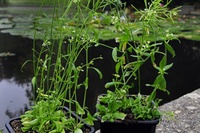Plant’s embryonic development: Maternal and paternal cooperation

Caption: Arabidopsis thaliana. Photo: Thomas Kunz
The Arabidopsis thaliana is a tiny, inconspicuous and herbaceous offshoot of the family of cruciferous plant that one might easily overlook in a meadow, yet the plant has the potential to disrupt a common school of thought:
Together with his working group and colleagues from the University of Nagoya, Japan, the Freiburg biologist Prof. Dr. Thomas Laux show how plants start embryo development and thereby follow a fundamentally different reproduction strategy than animals.
The team used the Arabidopsis thaliana as a model organism and showed how plants begin with gene transcription, that is genome reading, just hours after fertilization. That includes the genes that regulate the first steps in embryonic development. The researchers describe the newly found mechanism in the scientific journal „Genes and Development“.
From a biological standpoint, life begins after fertilization: The organism has a gene expression program that regulates embryonic development from a single zygote — that is, from the fusion of an egg cell and a sperm. In mammals, this new start occurs almost without any transcription in the zygote and rather uses gene transcripts and proteins that have been stored by the mother in the egg cell.
Plants, however, have chosen a different strategy to ensure the transcription of the correct genes in the zygote: an intracellular signal pathway, activated by the sperm, adds phosphate residues to the transcription factor WRKY2 and ensures communication between the cell membrane and nucleus.
As a consequence, this protein is enabled to activate the transcription of a master regulator, named WOX8, which controls the first steps of embryogenesis. In the case of the Arabidopsis thaliana, it includes, for instance, the formation of the shoot-root axis and the cell divisions that give rise to plant growth.
Nonetheless, WRKY2 alone cannot completely regulate the WOX8 transcription. It requires the help of additional transcription factors stemming from the maternal genes called HDG11 and HDG12. Only the combination of the sperm-activated WRKY2 and the maternally provided HDG proteins guarantees that the embryo regulation begins in the zygote. One obvious advantage of this collaboration is that the embryogenesis program is only activated when the egg cell and sperm fuse.
The study stands in contrast to the long-standing so-called „parental conflict theory“ that has been proposed for plants and mammals: This theory holds that for embryonic nourishment the two parents act antagonistically. Whereas paternal gene copies favor nutrient supply to only their own offspring, the maternal gene copies tend to favor the distribution of resources among all offspring. The findings of the research group suggest that one must assume a new model for the initiation of embryonic development of plants that relies on both parents’ cooperation.
Original publication:
Ueda, M., Aichinger, E., Gong, W., Groot, E., Verstraeten, I., Dai Vu, L., De Smet, I., Higashiyama, T., Umeda, M. and Laux, T. (2017). Transcriptional integration of paternal and maternal factors in the Arabidopsis zygote. Genes and Development 31, S. 617-662.
Thomas Laux’s research at the University of Freiburg
www.biologie.uni-freiburg.de/LauxLab/welcome.htm
Contact:
Prof. Dr. Thomas Laux
Institute of Biology III
University of Freiburg
Tel.: 0761/203-2943
E-Mail: laux@biologie.uni-freiburg.de
https://www.pr.uni-freiburg.de/pm/2017/mutter-und-vater-arbeiten-zusammen
Media Contact
All latest news from the category: Life Sciences and Chemistry
Articles and reports from the Life Sciences and chemistry area deal with applied and basic research into modern biology, chemistry and human medicine.
Valuable information can be found on a range of life sciences fields including bacteriology, biochemistry, bionics, bioinformatics, biophysics, biotechnology, genetics, geobotany, human biology, marine biology, microbiology, molecular biology, cellular biology, zoology, bioinorganic chemistry, microchemistry and environmental chemistry.
Newest articles

A new puzzle piece for string theory research
Dr. Ksenia Fedosova from the Cluster of Excellence Mathematics Münster, along with an international research team, has proven a conjecture in string theory that physicists had proposed regarding certain equations….

Climate change can cause stress in herring larvae
The occurrence of multiple stressors undermines the acclimatisation strategies of juvenile herring: If larvae are exposed to several stress factors at the same time, their ability to respond to these…

Making high-yielding rice affordable and sustainable
Plant biologists show how two genes work together to trigger embryo formation in rice. Rice is a staple food crop for more than half the world’s population, but most farmers…



